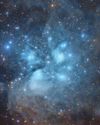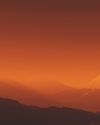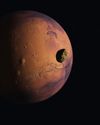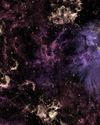Try GOLD - Free
CELESTRON STARSENSE EXPLORER DX 102AZ
All About Space UK
|Issue 146
Innovative technology provides the simplest and quickest solution yet to finding objects to observe, and this instrument will be very popular with beginners

The night sky is full of interesting objects that even a small telescope can show in detail, but actually finding them has always been a problem for beginners. The advent of computerised star catalogues loaded into telescope handsets made it possible to align a telescope on the sky by pointing it at just three bright stars. Once done, the handset could direct the telescope to any other object in its database, but it needed position encoders on its axes. And all this requires some user input – the date and time, the location and choosing the stars.
Then along came ‘plate solving’ – the software to identify a field of view of stars in a photograph – and the great computing power, position sensing and imaging capabilities of a modern smartphone. Celestron’s magic solution has been to link these to a telescope, doing away with the need for the costly handset, the user input and the encoders. Its StarSense technology links a smartphone to a telescope in a simple but robust fashion.

There are four instruments in the Celestron StarSense Explorer range: an 80mm refractor, a 114mm reflector, the 102mm refractor under test and a 130mm reflector. All of these instruments are standard members of the Celestron range and are available in other mounting packages. In this range, the 80mm refractor and 114mm reflector are supplied on lighter weight mountings, while the 102mm refractor and 130mm reflector have the same heavier mounting. Because these mountings use a standard Vixentype or CG-5 dovetail attachment, you can attach any other instrument that uses the same dovetail, taking into account the load capacity of the mounting.
This story is from the Issue 146 edition of All About Space UK.
Subscribe to Magzter GOLD to access thousands of curated premium stories, and 10,000+ magazines and newspapers.
Already a subscriber? Sign In
MORE STORIES FROM All About Space UK

All About Space UK
MYSTERIES OF THE UNI WHERE ARE ALL THE SPIRAL GALAXIES?
There are far fewer spiral galaxies than elliptical ones in the Supergalactic Plane, and scientists are keen to discover why
7 mins
Issue 161

All About Space UK
ZOMBIE STARS
+10 OTHER TERRIFYING SPACE OBJECTS
8 mins
Issue 161

All About Space UK
HOW TO BEAT LIGHT POLLUTION
Thought it was impossible to observe the wonders of the night sky from towns and cities? Think again. Follow our tips and tricks on successfully observing through sky glow
2 mins
Issue 161

All About Space UK
15 STUNNING STAR CLUSTERS
These beautiful stellar groupings are spattered across the cosmos
8 mins
Issue 161

All About Space UK
Eileen Collins "It was a difficult mission...we were the first to see Mir"
Having served as both the first female pilot and first female commander of NASA's Space Shuttle, Collins boosted the involvement of women in space exploration to a whole new level
9 mins
Issue 161

All About Space UK
MARS LEAKS FASTER WHEN IT'S CLOSER TO THE SUN
The Red Planet has lost enough water to space to form a global ocean hundreds of kilometres deep
2 mins
Issue 161

All About Space UK
FUTURE TECH KANKOH-MARU
This ambitious reusable spacecraft will be capable of taking 50 people to and from orbit
2 mins
Issue 161

All About Space UK
THE FINAL FRONTIER
Beyond the reach of the Sun is a fascinating region of the cosmos that were only just beginning to explore
8 mins
Issue 161

All About Space UK
A long-lost moon could explain Mars' weird shape and extreme terrain
A long-lost moon could explain why Mars is so different from the other rocky planets in the Solar System. Today Mars has two tiny moons.
2 mins
Issue 161

All About Space UK
A sprinkling of cosmic dust may have helped kick-start life on Earth
Cosmic dust may have helped kick-start life on Earth. New findings challenge a widely held assumption that this wasn't a plausible explanation.
3 mins
Issue 161
Translate
Change font size
